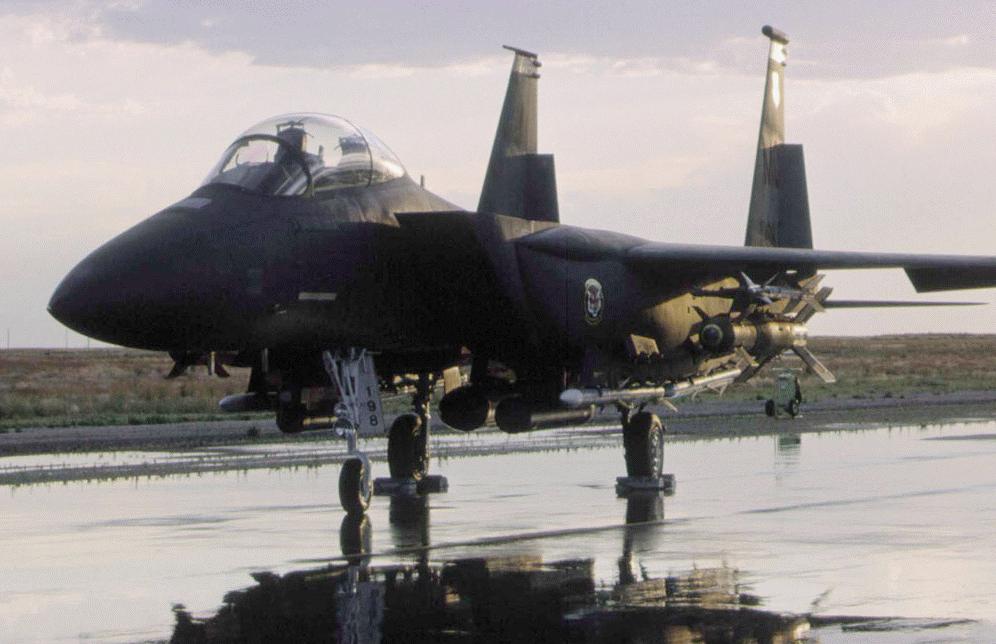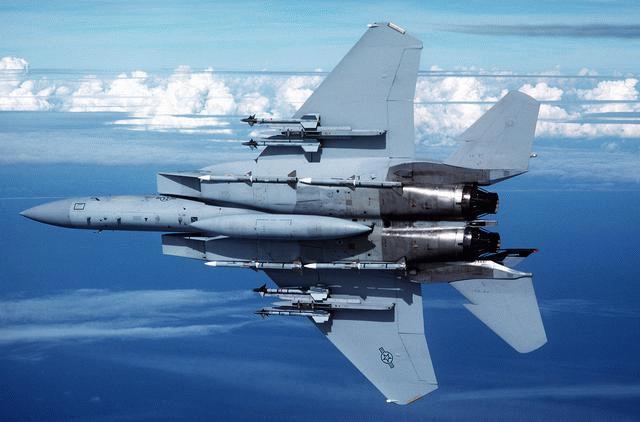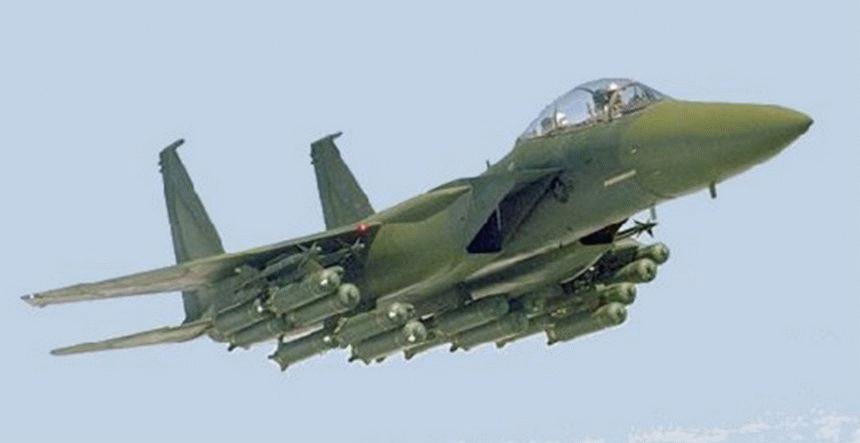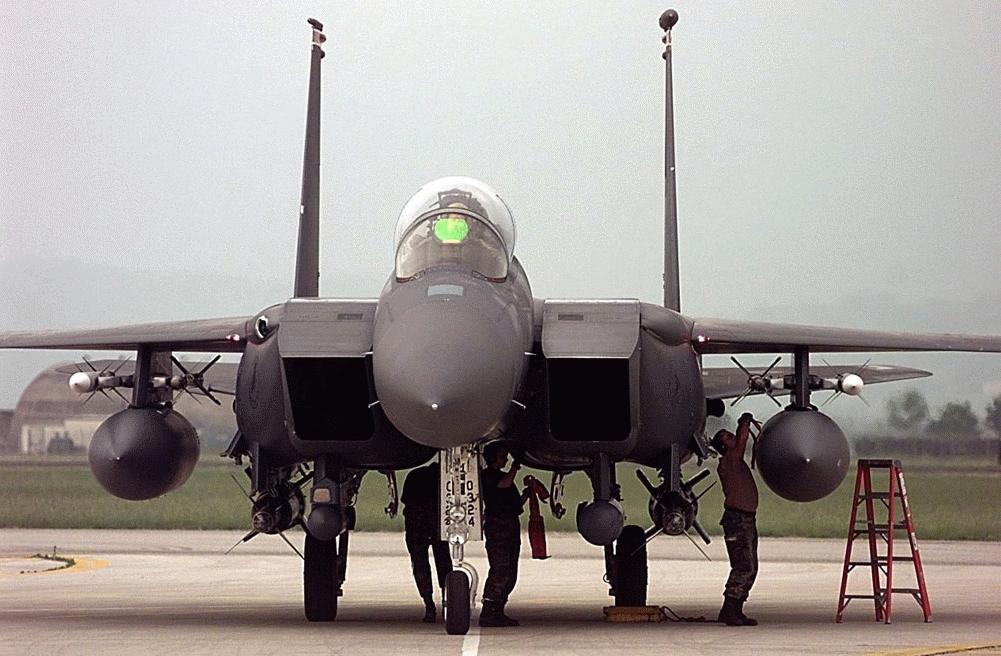
Primary Function Tactical fighter.
Contractor McDonnell Douglas Corp.
Power Plant Two Pratt & Whitney F100-PW-100 turbofan engines with
Thrust (C/D models) 25,000 pounds each engine ( 11,250 kilograms).
Length 63 feet, 9 inches (19.43 meters).
Height 18 feet, 8 inches (5.69 meters).
Wingspan 42 feet, 10 inches (13.06 meters)
Speed 1,875 mph (Mach 2.5-plus) at 45,000 ft.
Ceiling 65,000 feet (19,697 meters).
Maximum Takeoff Weight(C/D models) 68,000 pounds (30,600 kilograms).
Range 3,450 miles (3,000 nautical miles) ferry range .
Armament
1 - M-61A1 20mm multibarrel internal gun, 940 rounds of ammunition4 - AIM-9L/M Sidewinder and 4 - AIM-7F/M Sparrow missiles, orcombination of AIM-9L/M, AIM-7-F/M and AIM-120 missiles

F-15 Eagle
The F-15 Eagle is an all-weather, extremely maneuverable, tactical fighter designed to gain and maintain air superiority in aerial combat. The Eagle's air superiority is achieved through a mixture of maneuverability and acceleration, range, weapons and avionics. The F-15 has electronic systems and weaponry to detect, acquire, track and attack enemy aircraft while operating in friendly or enemy-controlled airspace. Its weapons and flight control systems are designed so one person can safely and effectively perform air-to-air combat. It can penetrate enemy defense and outperform and outfight current or projected enemy aircraft.
The F-15's superior maneuverability and acceleration are achieved through high engine thrust-to-weight ratio and low wing loading. Low wing-loading (the ratio of aircraft weight to its wing area) is a vital factor in maneuverability and, combined with the high thrust-to-weight ratio, enables the aircraft to turn tightly without losing airspeed.

A multimission avionics system sets the F-15 apart from other fighter aircraft. It includes a head-up display, advanced radar, inertial navigation system, flight instruments, UHF communications, tactical navigation system and instrument landing system. It also has an internally mounted, tactical electronic-warfare system, "identification friend or foe" system, electronic countermeasures set and a central digital computer.
Through an on-going multistage improvement program the F-15 is receiving extensive upgrade involving the installation or modification of new and existing avionics equipment to enhance the tactical capabilities of the F-15.
The head-up display projects on the windscreen all essential flight information gathered by the integrated avionics system. This display, visible in any light condition, provides the pilot information necessary to track and destroy an enemy aircraft without having to look down at cockpit instruments.
The F-15's versatile pulse-Doppler radar system can look up at high-flying targets and down at low-flying targets without being confused by ground clutter. It can detect and track aircraft and small high-speed targets at distances beyond visual range down to close range, and at altitudes down to tree-top level. The radar feeds target information into the central computer for effective weapons delivery. For close-in dog fights, the radar automatically acquires enemy aircraft, and this information is projected on the head-up display.

The APG-63 radar was developed over 20 years ago and has an average mean time between failure less than 15 hours. APG-63 LRUs have become increasingly difficult to support both in the field and at the depot. First, individual parts have become increasingly unavailable from any source; incorporating newer technology parts often entails module redesign and fails to address the root cause. Second, continuing reliability deterioration impacts both sustainment, particularly during deployment, as well as ACC’s ability to implement two-level maintenance. In addition, the APG-63 radar has virtually no remaining processing and memory capacity to accommodate software upgrades to counter evolving threats. The APG-63(V)1 radar has been designed for improved reliability and maintainability to address user requirements. The radar incorporates components designed for improved reliability and lower failure rates and enhanced diagnostics for improved fault detection and fault isolation. Along with other design features, these should improve radar reliability to 120 hours MTBM, an order of magnitude better than the existing APG-63.

An inertial navigation system enables the Eagle to navigate anywhere in the world. It gives aircraft position at all times as well as pitch, roll, heading, acceleration and speed information.
The F-15's electronic warfare system provides both threat warning and automatic countermeasures against selected threats. The "identification friend or foe" system informs the pilot if an aircraft seen visually or on radar is friendly. It also informs U.S. or allied ground stations and other suitably equipped aircraft that the F-15 is a friendly aircraft.
The Fiber Optic Towed Decoy (FOTD) provides aircraft protection against modern radar-guided missiles to supplement traditional radar jamming equipment. The device is towed at varying distances behind the aircraft while transmitting a signal like that of a threat radar. The missile will detect and lock onto the decoy rather than on the aircraft. This is achieved by making the decoy’s radiated signal stronger than that of the aircraft.
A variety of air-to-air weaponry can be carried by the F-15. An automated weapon system enables the pilot to perform aerial combat safely and effectively, using the head-up display and the avionics and weapons controls located on the engine throttles or control stick. When the pilot changes from one weapon system to another, visual guidance for the required weapon automatically appears on the head-up display.

The Eagle can be armed with combinations of four different air-to-air weapons: AIM-7F/M Sparrow missiles or AIM-120 Advanced Medium Range Air-to-Air Missiles on its lower fuselage corners, AIM-9L/M Sidewinder or AIM-120 missiles on two pylons under the wings, and an internal 20mm Gatling gun (with 940 rounds of ammunition) in the right wing root.
The current AIM-9 missile does not have the capabilities demonstrated by foreign technologies, giving the F-15 a distinct disadvantage during IR dogfight scenarios. AIM-9X integration will once again put the F-15 in the air superiority position in all arenas. The F-15/AIM-9X weapon system is to consist of F-15 carriage of the AIM-9X missile on a LAU-128 Air-to-Air (A/A) launcher from existing AIM-9 certified stations. The AIM-9X will be an upgrade to the AIM-9L/M, incorporating increased missile maneuverability and allowing a high off-boresight targeting capability.

Low-drag, conformal fuel tanks were especially developed for the F-15C and D models. Conformal fuel tanks can be attached to the sides of the engine air intake trunks under each wing and are designed to the same load factors and airspeed limits as the basic aircraft. Each conformal fuel tank contains about 114 cubic feet of usable space. These tanks reduce the need for in-flight refueling on global missions and increase time in the combat area. All external stations for munitions remain available with the tanks in use. AIM-7F/M Sparrow and AIM-120 missiles, moreover, can be attached to the corners of the conformal fuel tanks.

The F-15 Eagle began its life in the mid 1960s as the Fighter Experimental (FX) concept. Using lessons learned in Vietnam, the USAF sought to develop and procure a new, dedicated air superiority fighter. Such an aircraft was desperately needed, as no USAF aircraft design solely conceived as an air superiority fighter had become reality since the F-86 Sabre. The intervening twenty years saw a number of aircraft performing the air-to-air role as a small part of their overall mission, such as the primarily air-to-ground F-4 Phantom and the F-102, F-104 and F-106 interceptor designs. The result of the FX study was a requirement for a fighter design combining unparalleled maneuverability with state-of-the-art avionics and weaponry. An industry-wide competition ended on December 23, 1969 when McDonnell Douglas was awarded the contract for the F-15.

The first F-15A flight was made on 27 July 1972, culminating one of the most successful aircraft development and procurement programs in Air Force history. After an accident-free test and evaluation period, the first aircraft was delivered to the Air Force on Novermber 14, 1974. In January 1976, the first Eagle destined for a combat squadron was delivered to the 1st Tactical Fighter Wing at Langley Air Force Base, Va. Three hundred and sixty-five F-15As were built before production of the F-15C began in 1978. In January 1982, the 48th Fighter-Interceptor Squadron at Langley Air Force Base became the first Air Force air defense squadron to transition to the F-15. After twenty years of service, the F-15A has recently been reassigned from active duty Air Force fighter squadrons to Air National Guard units. The F-15A is flown by Air National Guard squadrons in the states of Oregon, Missouri, Georgia, Louisiana, Hawaii, and Massachussets.

The first flight of the two-seat F-15B (formerly TF-15A) trainer was made in July 1973. The first F-15B Eagle was delivered in November 1974 to the 58th Tactical Training Wing, Luke Air Force Base, Ariz., where pilot training was accomplished in both F-15A and B aircraft. The F-15B incorporates a tandem seating configuration, with a second crewmember position aft of the pilot's seat. The primary purpose of the F-15B is aircrew training, with an instructor pilot occupying the rear seat while an upgrading pilot mans the front seat controls.

The rear seat pilot has a full set of flight controls and can fly the aircraft throughout the envelope, including takeoff and landing. Even though space is sacrificed to accomodate the second crew member, the F-15B retains the same warfighting capability as the F-15A. In keeping with the trainer concept, however, the rear seat is not equipped with controls for the combat avionics and weaponry. In fact, the rear seat is not a mandatory crew position, and F-15Bs are often flown with empty rear cockpits.
No comments:
Post a Comment